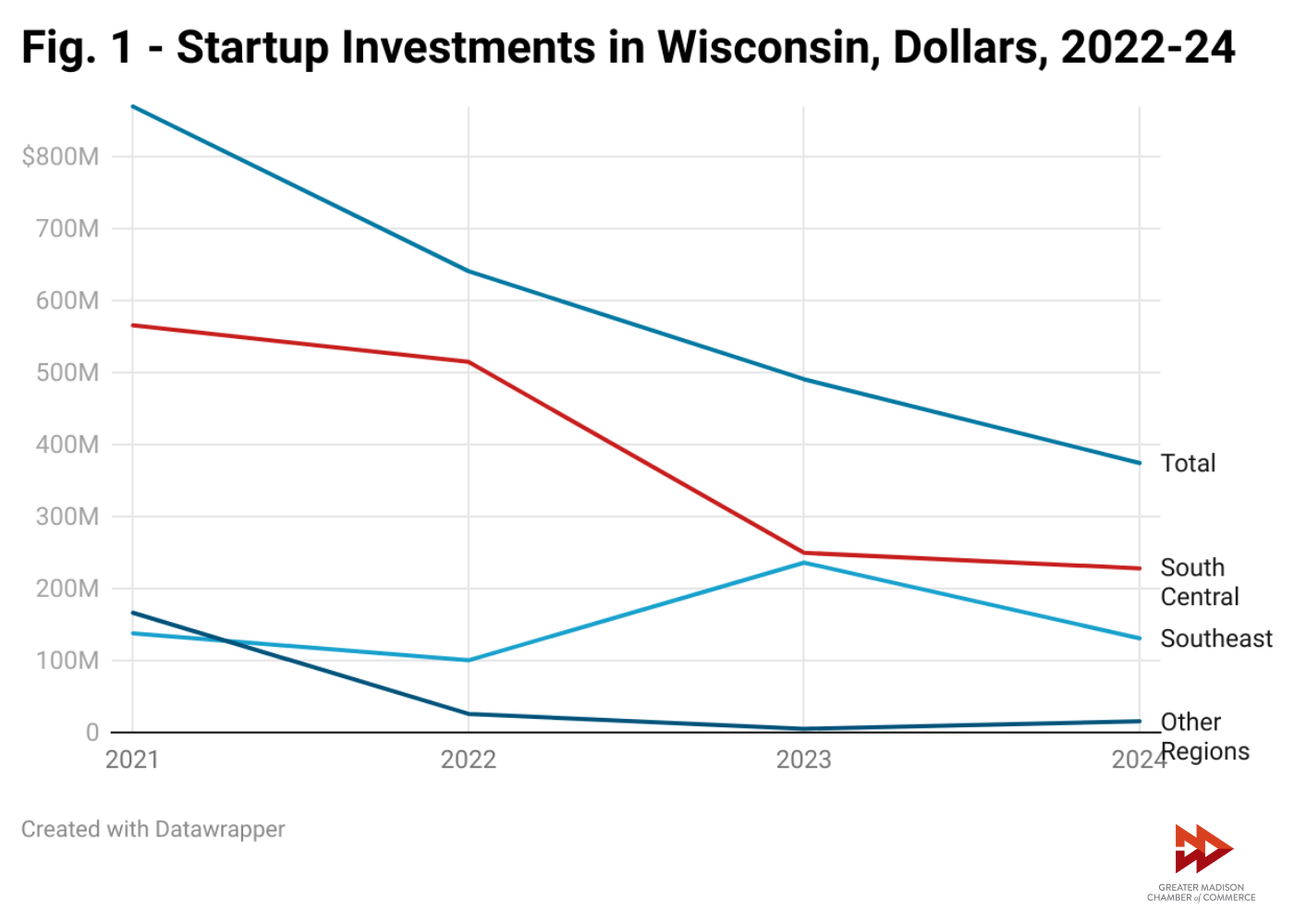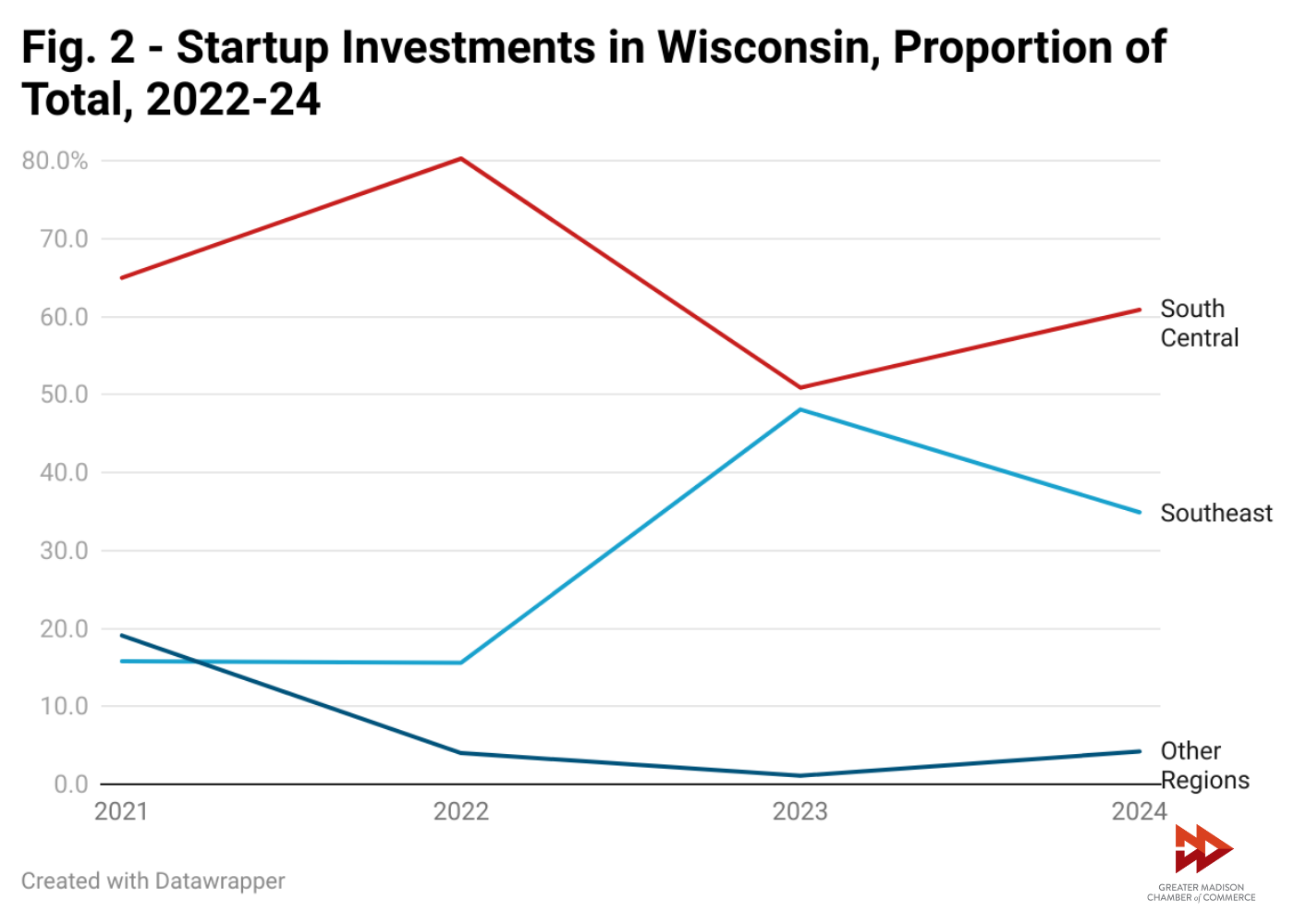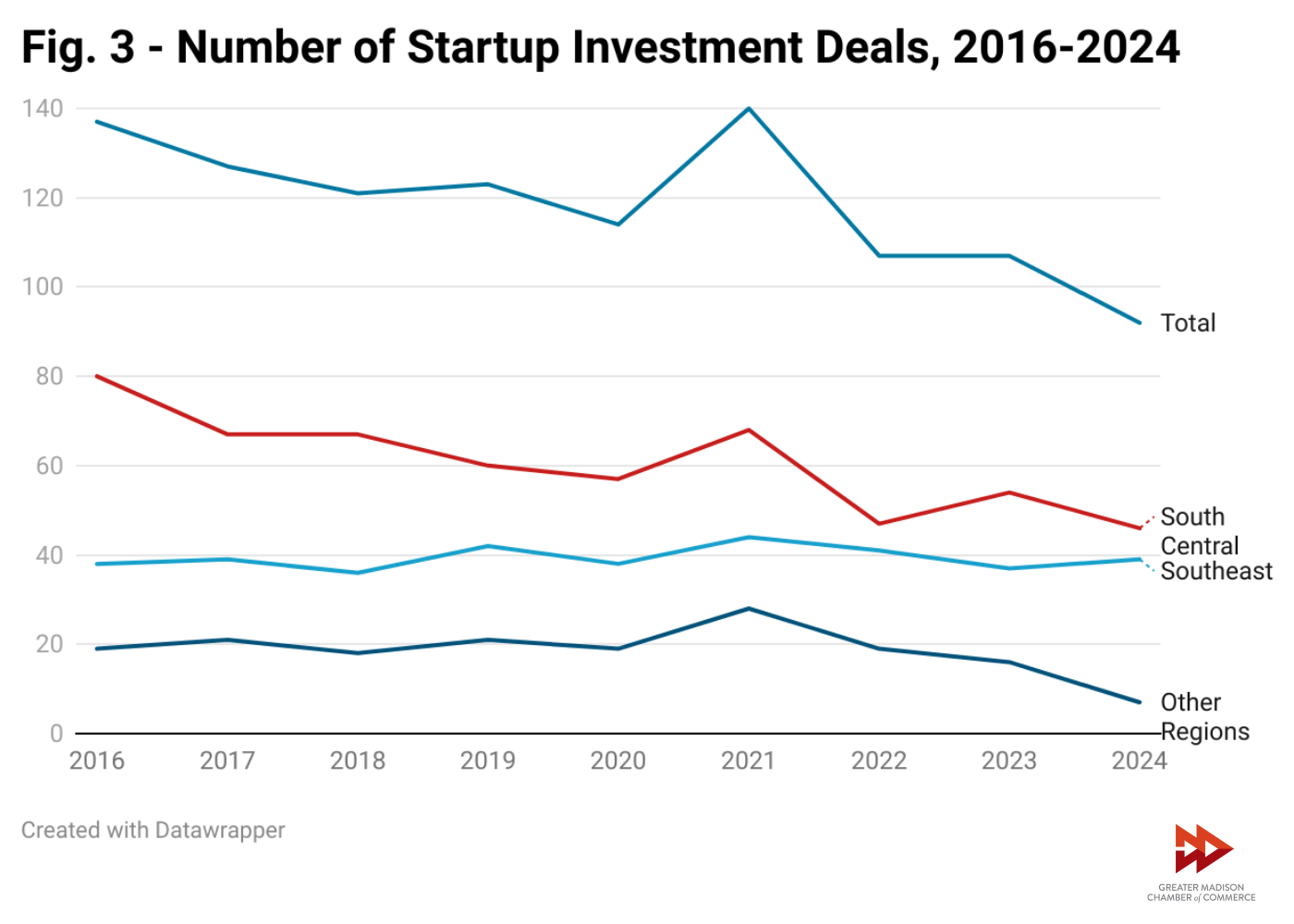Category: Economy News
Photo by Richard Hurd
Metro Metrics December 2025

Metro Metrics is a monthly data snapshot that explores key economic indicators reflecting the health of the Madison metro economy.
Q3 Economic Update
This month’s edition of Metro Metrics examines key indicators of Greater Madison’s economy and how they fared during Q3 of 2025.
Industries
The Metro’s job numbers began rebounding after decreasing slightly earlier this year (Table 1). Total nonfarm jobs in September exceeded last year’s total jobs for the first time since April. The industries that have grown the most are leisure and hospitality (up 5.1%) and education and health services (up 2.3%). Employment in trade, transportation and utilities decreased by 2.2% since last year.
Labor Force
Greater Madison continues to have a lower unemployment rate than the state of Wisconsin and the nation (Table 2). The Metro’s unemployment rate of 2.3% is fifth lowest out of 387, after only Sioux Falls, SD (1.8%), Rapid City, SD (1.9%), Bismarck, ND (2.0%) and Honolulu, HI (2.2%). The region’s labor force, employed people and unemployed people all decreased since last year. Total labor force decreased by 2.7%, employed people decreased by 2.8% and unemployed people decreased by 6.2%. These figures reinforce findings in the 2025 Next Normal (N²) survey, showing talent attraction and retention as the top barrier to business growth. It also reinforces the importance of talent development and effectively aligning education, training and industry needs to expand the available workforce.
Housing Building Permits
Due to the government shutdown earlier this year, Census Building Permits data for September has not been released, so this section will only cover building permits up to August (Table 3). The Metro has permitted more housing units this year YTD than last year, with nearly 4,200 housing units approved – an increase of about 5.6%.
MSN Airport Update
This year’s Dane County Regional Airport passenger counts YTD surpassed pre-pandemic records and are on track to be the airport’s best year yet (Table 4). For more information on how the airport is doing and what its future plans are, the Chamber recently hosted an edition of our Lunch(UP)date program with the airport’s new Executive Director, Mark Papko.
In addition to traffic counts, the airport also recently announced new nonstop service to Boston – one of the most requested business destinations.
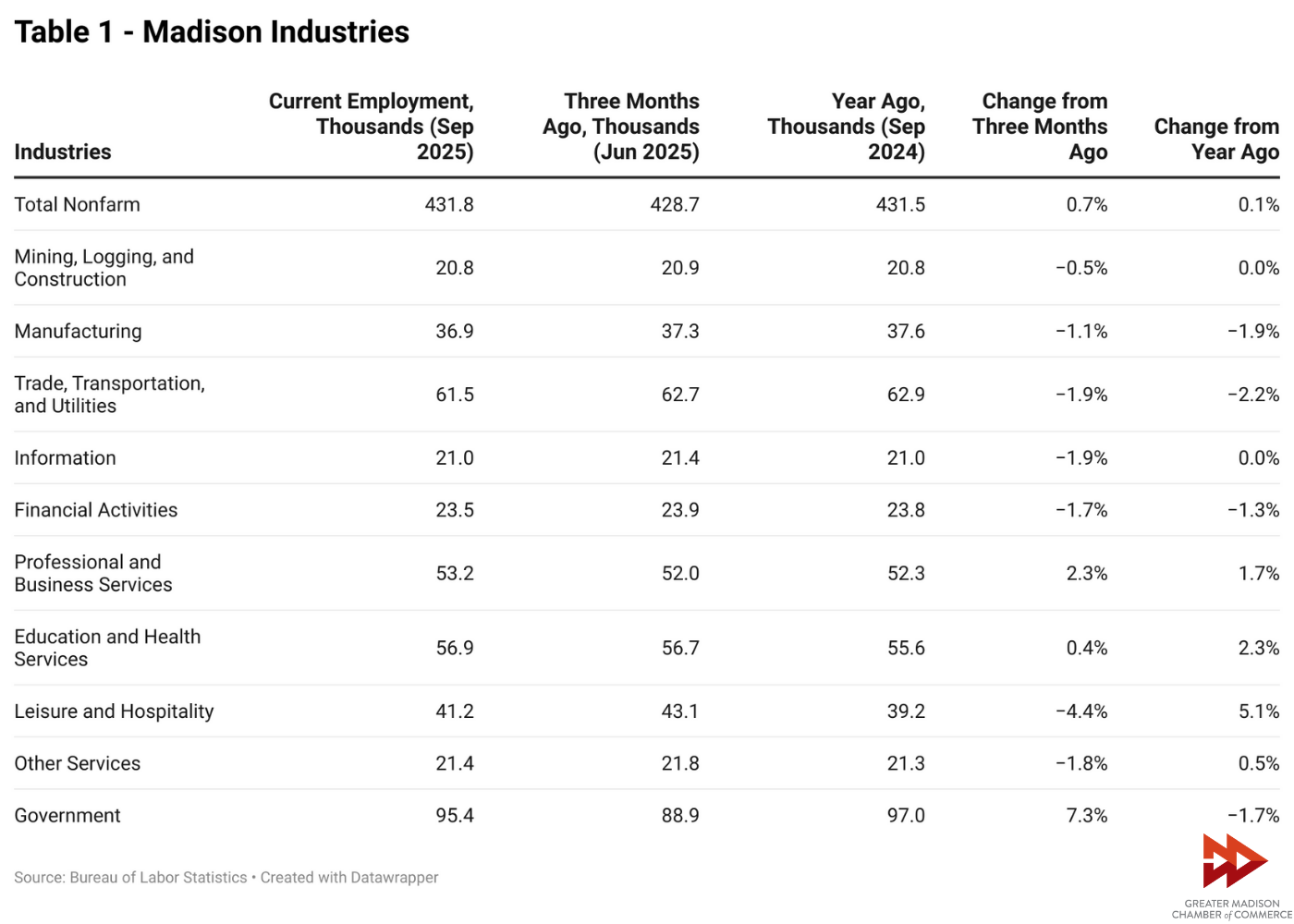

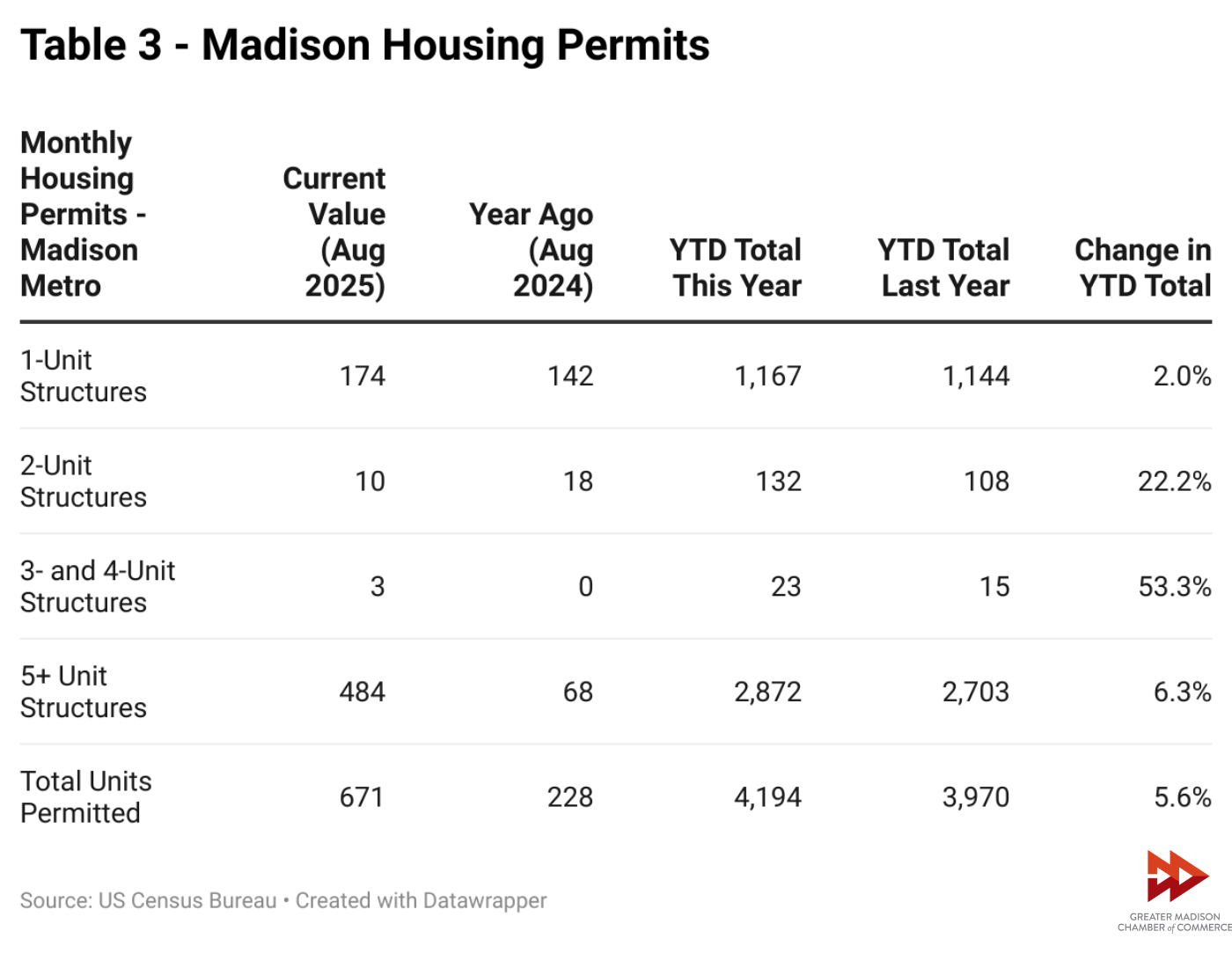
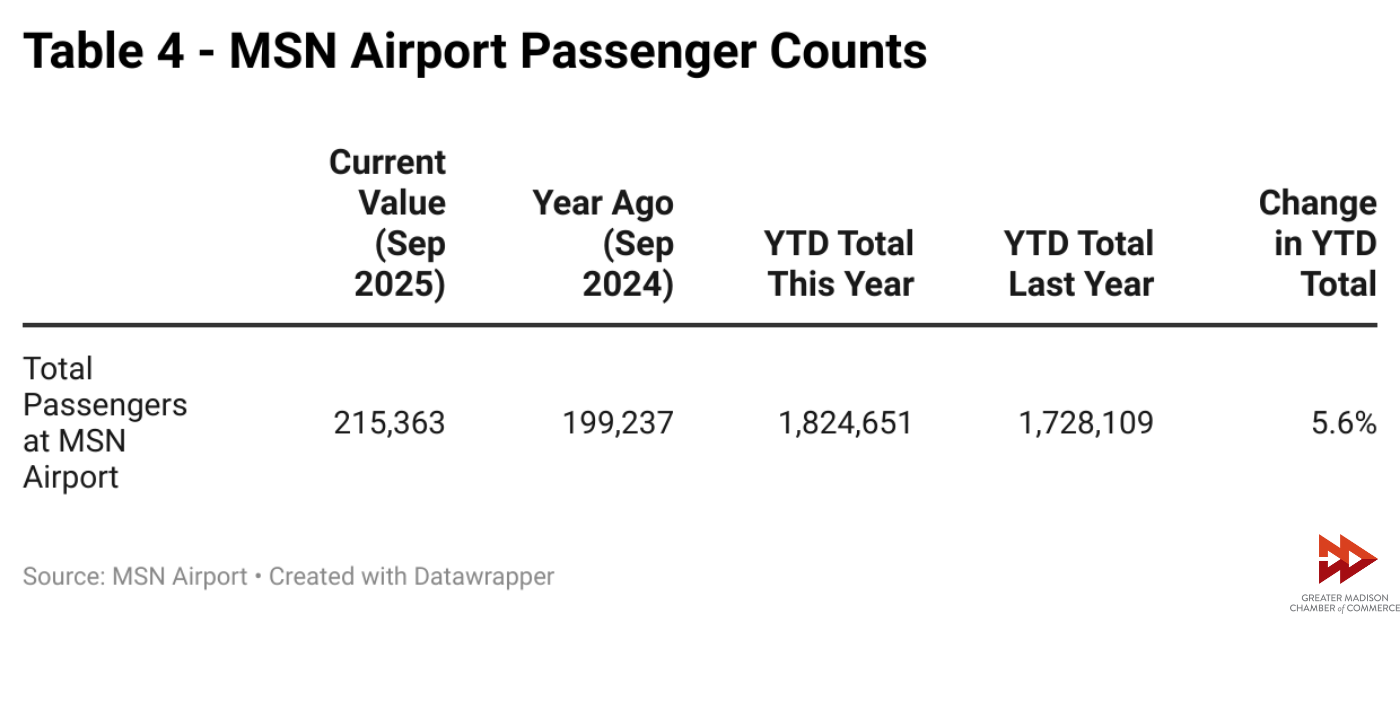
Photo by Richard Hurd
Greater Madison Chamber of Commerce to Integrate MadREP’s Work, Creating a Unified Force for Regional Economic Development
FOR IMMEDIATE RELEASE (Dec. 12, 2025)
Contact: Communications Manager Jess Miller, jess@madisonbiz.com, (608) 443-1952
Greater Madison Chamber of Commerce to Integrate MadREP’s Work, Creating a Unified Force for Regional Economic Development
Move reflects organizations’ shared commitment to region’s future
MADISON, WI — Today, the Madison Region Economic Partnership (MadREP) and the Greater Madison Chamber of Commerce (GMCC) announced a new chapter in regional economic development. Following a year of collaborative discussions and joint planning, MadREP will now transfer its regional economic development responsibilities, creating a more unified structure to accelerate growth and opportunity across south-central Wisconsin.
“This transition reflects our shared belief that the region is stronger when we work together,” said MadREP Board Chair Jason Vangalis. “MadREP’s foundation of collaboration and partnership has positioned the region for success, and this move ensures that work continues with even greater capacity.”
GMCC Board Chair Dan Bertler added: “Regional collaboration has always been essential to achieving greater outcomes. A unified structure will deliver a more effective model and enable coordinated action on our region’s shared priorities.”
GMCC will immediately assume regional economic development responsibilities and, beginning in early 2026, will collaborate in partnership with public- and private-sector leaders on a focused regional strategy that builds upon MadREP’s foundational work.
“This is a natural evolution built on years of partnership,” said GMCC President Zach Brandon. “Integrating MadREP’s work with the region’s largest business association will create a customer-centric approach to increase opportunities and ensure our current growth translates into lasting regional benefits.”
###
Photo by Richard Hurd
Metro Metrics November 2025

Metro Metrics is a monthly data snapshot that explores key economic indicators reflecting the health of the Madison metro economy.
The Next Normal for Greater Madison
Since 2024, the Chamber, in coordination with several partner organizations, has conducted an annual survey of regional employers to assess current and projected economic conditions. These surveys are designed to help us understand the Next Normal (N²) for work and workplaces in our region.
This year’s survey received responses from 241 unique businesses representing 20 different industries. Topline results and partner perspectives were shared at a recent Chamber Lunch(UP)date, which can be viewed here. For this month’s Metro Metrics, we take a closer look at the data to assess trends and peer metro comparisons.
Business Indicators
There were many encouraging results for both the availability (Fig. 1) and quality of talent (Fig. 2), with both metrics showing increases in the proportion of businesses that reported them as “average” or better compared to last year’s survey. Similar increases were found in respondent views on the region’s business climate (Fig. 3).
The distribution of responses to these business indicators is shown below. A consistent pattern can be observed in all three measurements. The proportion of businesses that rated these indicators “poor” or “below average” always drops from 2024 to 2025 and the proportion that rated them “above average” or “excellent” always rises. The proportion that rated the indicators “average” either increased or decreased, depending on the indicator. This shows that the improvement isn’t just due to ratings trending towards the middle but that businesses are rating them higher.
Another way to visualize and understand the difference between 2024 and 2025 ratings for these indicators is by creating an index (Fig. 4) to measure the difference between how many businesses rated these indicators above average or better and how many rated them below average or worse. The index scales from 0 to 100, with 0 meaning every business rated it negatively, 50 meaning an equal number of businesses rated it positively and negatively and 100 meaning every business rated it positively.
All three indicator indices are above 50 in both survey years, indicating that more businesses felt positively than negatively about the indicators. All three also increased between last year and this year, demonstrating improvement.
How Does Greater Madison Measure Up?
Recently, the U.S. Chamber of Commerce released its 2025 Empowering Small Business Report, which summarizes the results of a national survey of small businesses. The U.S. Chamber defines small businesses as those with fewer than 250 employees, which differs from how the N2 survey categorized businesses. To get the closest approximation for this comparison, we will define Greater Madison’s small businesses as those with fewer than 200 employees.
This year’s Empowering Small Business report focused on AI and how small businesses are using it. According to the report, 40% of small businesses were using AI in 2024, rising to 58% in 2025. AI use among Greater Madison small businesses was 48% in 2024 and 75% in 2025, showing faster AI adoption locally. Similarly, a moderately higher percentage of Greater Madison small businesses are developing custom AI tools compared to the nation.
An additional survey we can use to compare AI trends is McKinsey’s State of AI 2025 report. This report found that although a majority of companies use AI, its use is concentrated in the “experimenting” and “piloting” phases. Just one-third of businesses said their AI use was “scaling” or “fully scaled.” This is similar to the results from N2, where 58% of businesses said that AI was only “minimally integrated” into their workflows.
Tariffs and Uncertainty
Two significant findings from this year’s survey were the proportion of businesses concerned about tariffs and those facing more uncertainty this year than last year (Fig. 5). The proportion of respondents that listed tariffs as a barrier to their business increased from 5% in 2024, representing the least common barrier, to 36% in 2025, the third-highest barrier. A majority (51%) of surveyed businesses said they were experiencing more uncertainty this year than last year.
The industries most concerned about tariffs this year were retail, advanced manufacturing, arts and entertainment, and construction and trades. While it is not surprising to see industries that are import- or export-dependent identify concerns about trade and tariffs, it is notable that 50% of arts and entertainment businesses that took the survey identified tariffs as a top barrier.
The industries that said they were facing more uncertainty than last year were nonprofit, arts and entertainment, business and professional services, retail, and bioscience. Bioscience employers faced only slightly more uncertainty than the general sample, but because it is a driver industry for the region’s economy, it is worth noting and tracking.
Business size also had a large effect on whether businesses reported facing more uncertainty, with more than 60% of smaller businesses reporting increased levels of uncertainty while less than 30% of larger businesses reported the same.
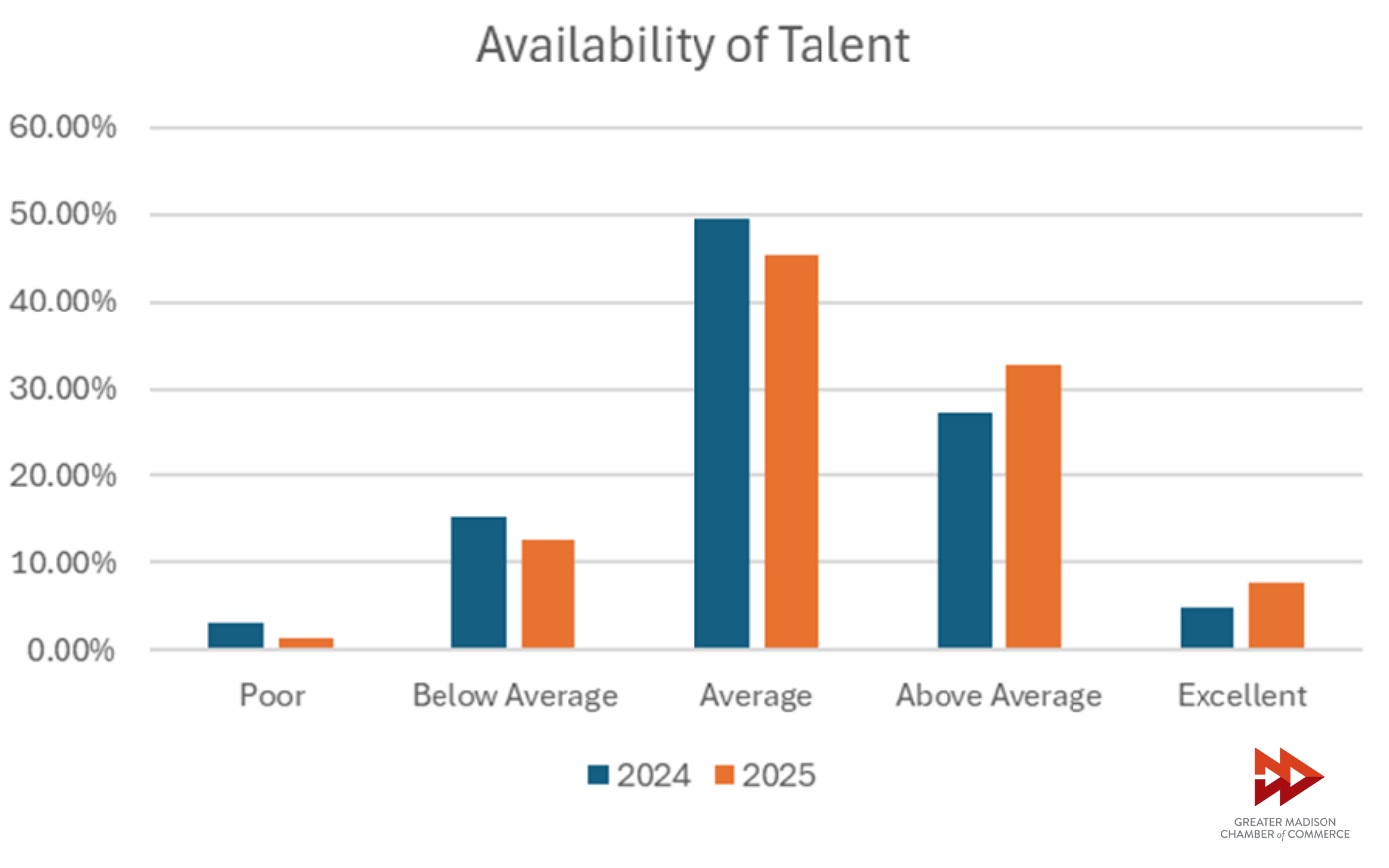
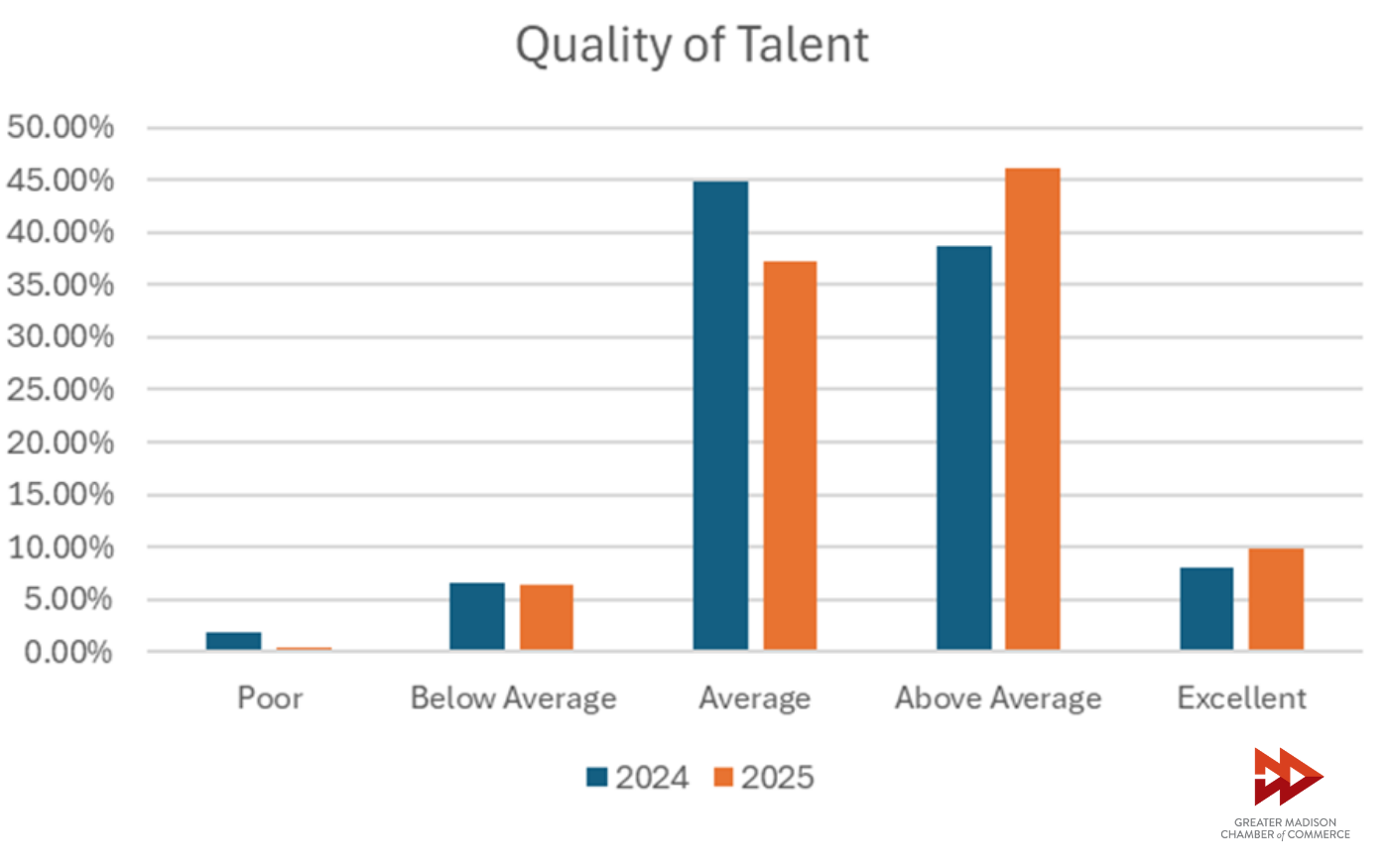
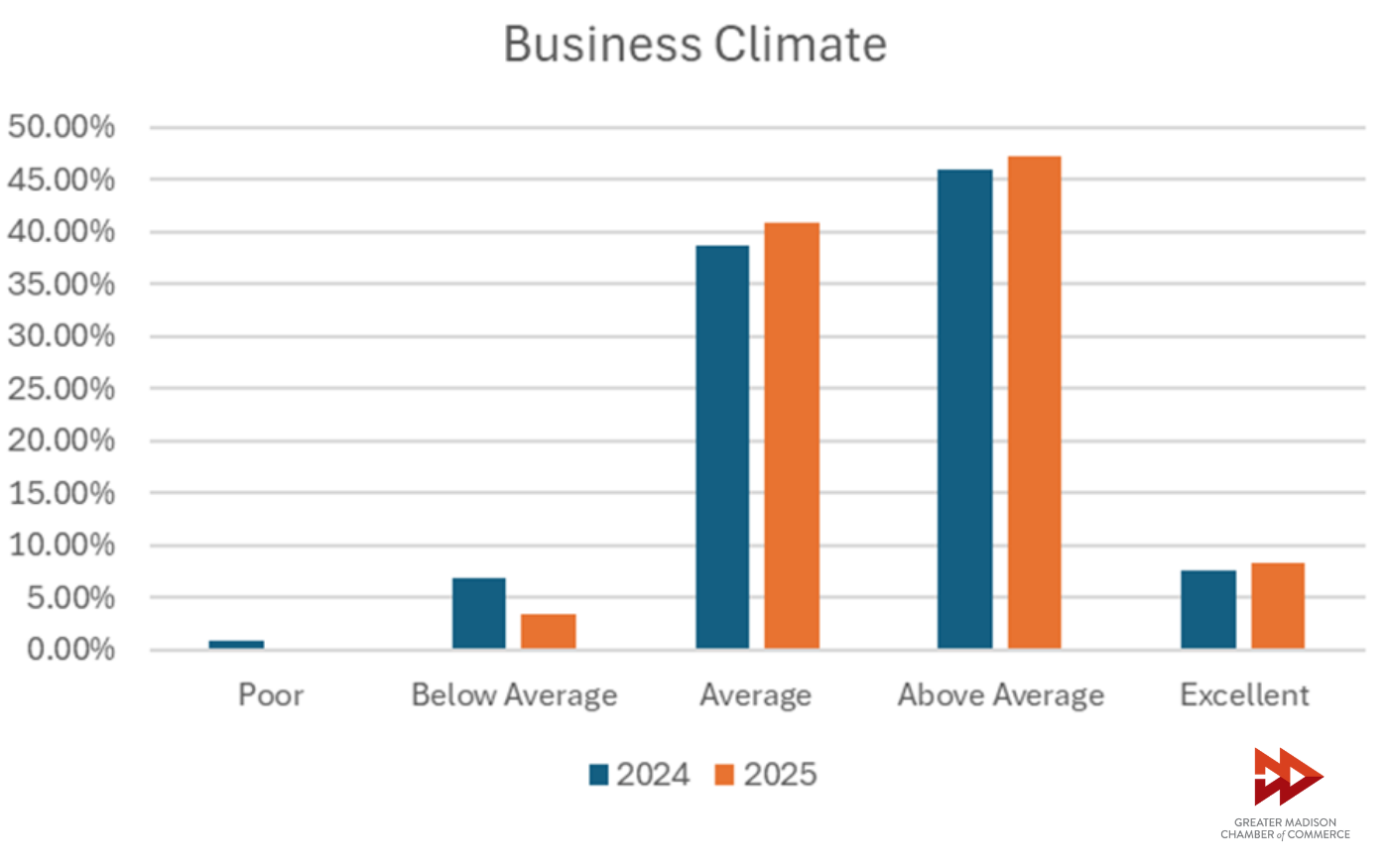
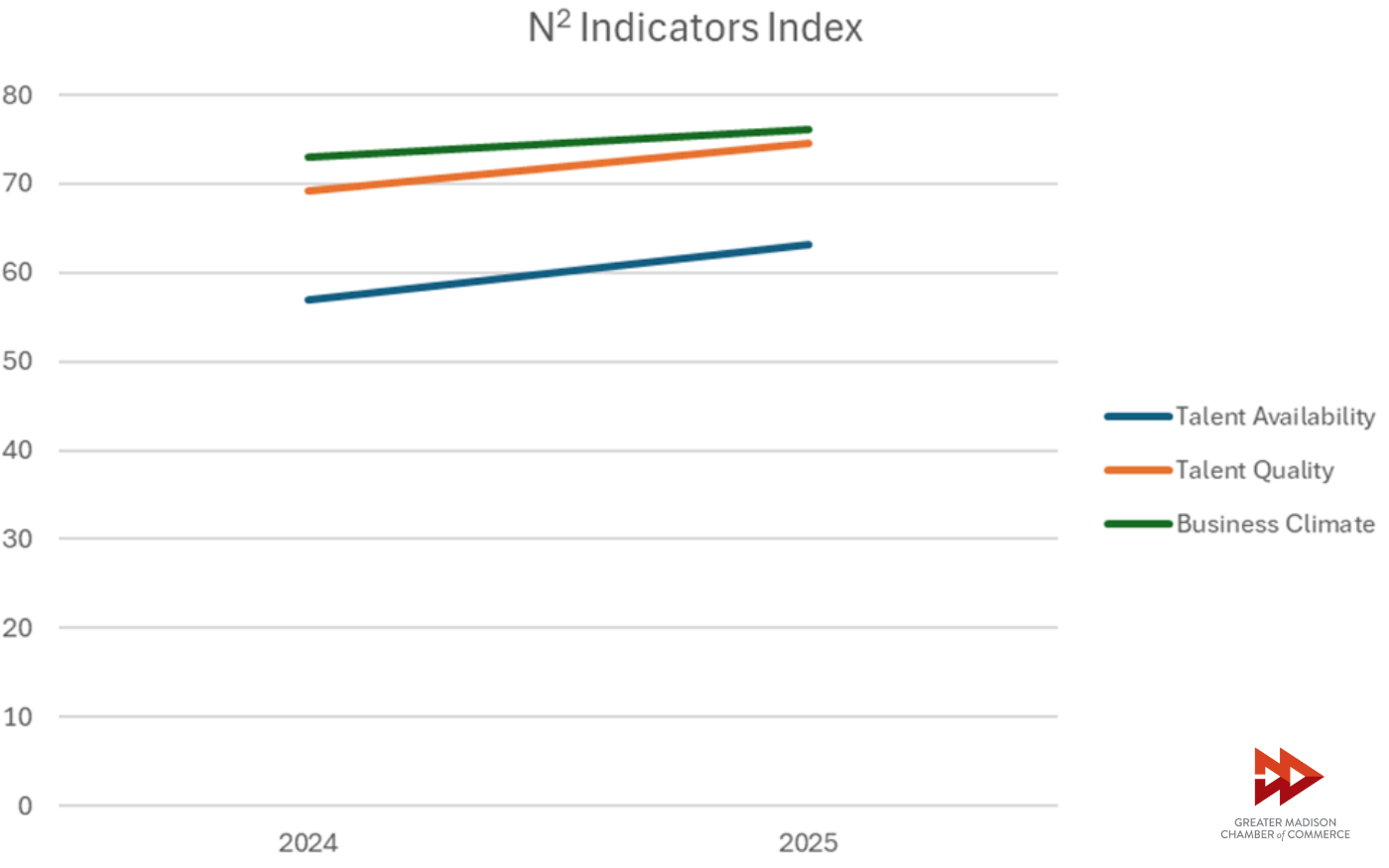
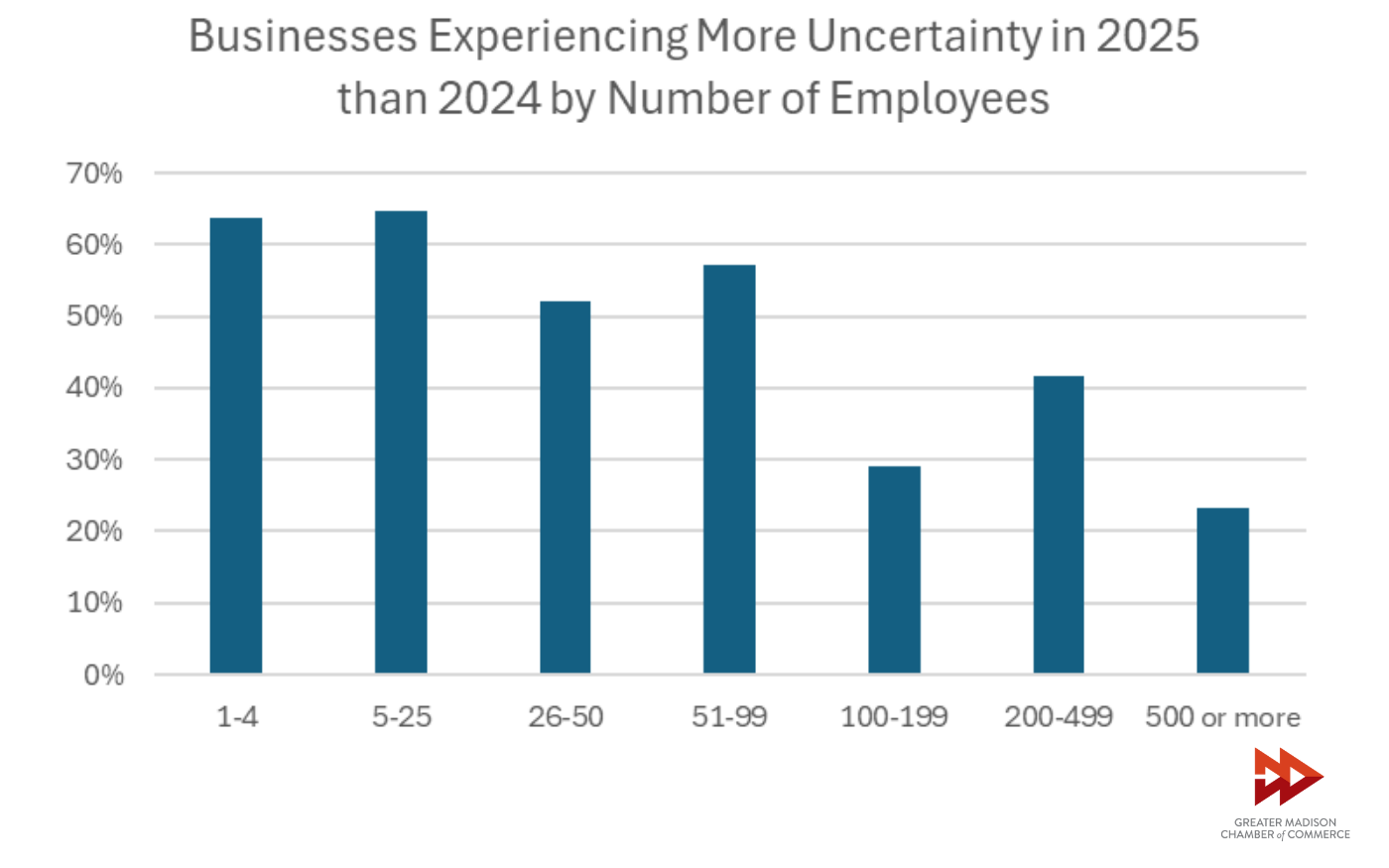
Photo by Richard Hurd
Metro Metrics October 2025

Metro Metrics is a monthly data snapshot that explores key economic indicators reflecting the health of the Madison metro economy.
Madison’s Export Markets
In this month’s Metro Metrics, we examine Greater Madison’s export activity to better understand the region’s economic connectivity to global markets.
In 2023, the top five categories of goods that the Madison Metro exported were chemicals, computer and electronic products, machinery, electrical equipment, and processed foods (Fig. 1). Processed foods was a recent addition to the top five, displacing miscellaneous manufacturing. Chemicals are the largest export category by total dollar amount, making up roughly 23% of Greater Madison’s total exports, followed by computer and electronic products at 21%. These two categories account for nearly half of the Metro’s total foreign exports of $2.9 billion in 2023. Total exports have been increasing over time. Exports as a proportion of the Metro’s GDP have remained roughly constant, fluctuating between 4% and 6% since 2005.
The value of these exports lies not just in the dollars they bring to the region, but also in their employment effects. Fig. 2, which graphs total chemical exports from the Madison Metro plotted against regional employment in the chemical manufacturing industry, shows a strong correlation (R^2=0.88) between the two. The least-squares regression indicates that, on average, every $250,000 in chemical exports from the Madison Metro supports one additional job in the chemical manufacturing sector. The chemical manufacturing NAICS code includes many different subsectors, including pharmaceuticals and medicine, which is part of Greater Madison’s renowned Biohealth ecosystem.
Based on trade data published by the ITA (Fig. 3), the largest group of countries Greater Madison exports to is the Asia-Pacific Economic Cooperation (APEC), which includes most nations bordering the Pacific. In 2023, this group of 20 nations was the destination for more than half of Greater Madison’s exports and has accounted for between 52% and 62% of the Metro’s exports since 2005. Two of the nations in APEC, Canada and Mexico, are also part of the United States-Mexico-Canada Agreement (USMCA). In 2023, the USMCA countries received roughly one-quarter of Greater Madison’s exports, a proportion which has ranged between 22% and 38% since 2005.
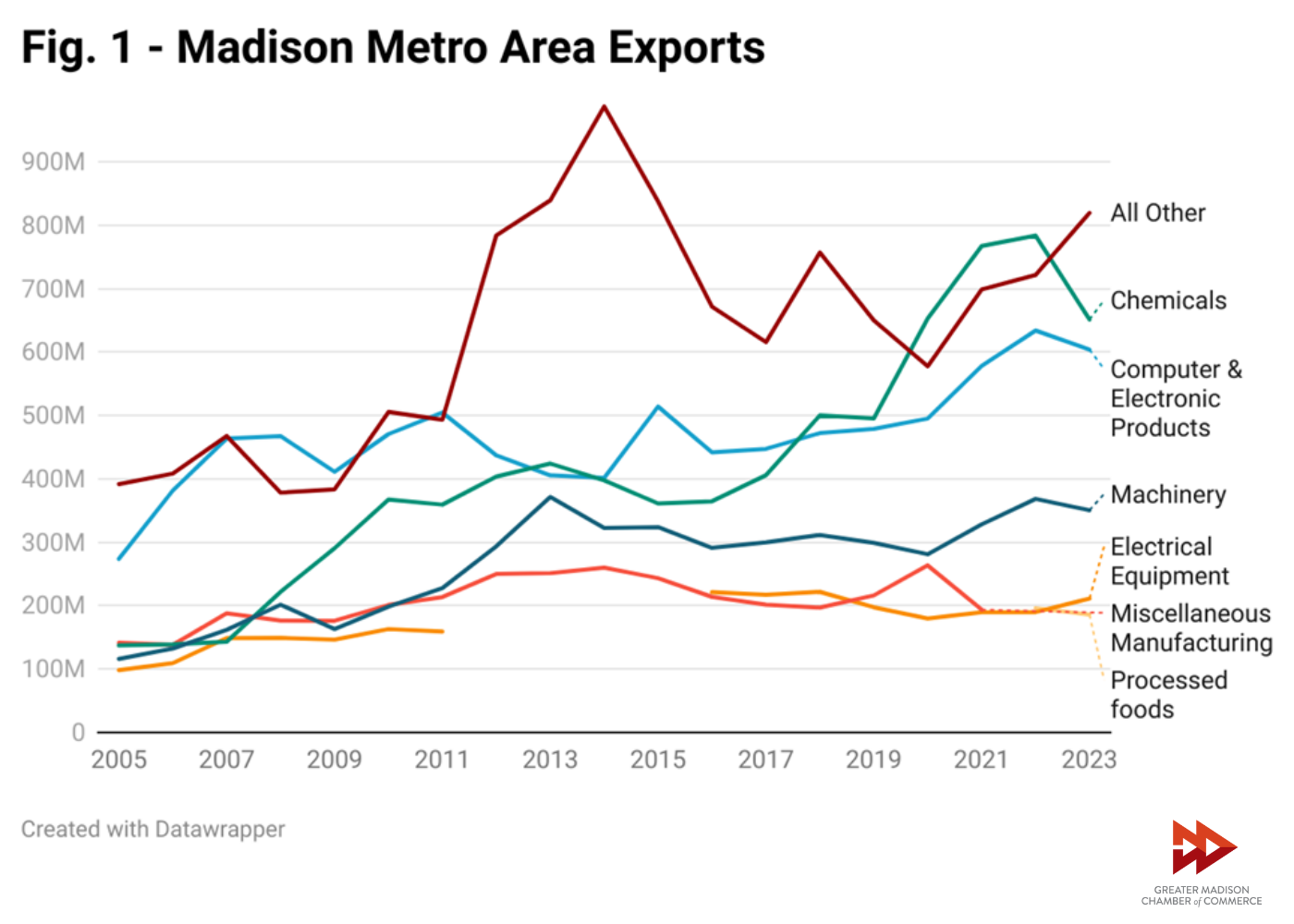
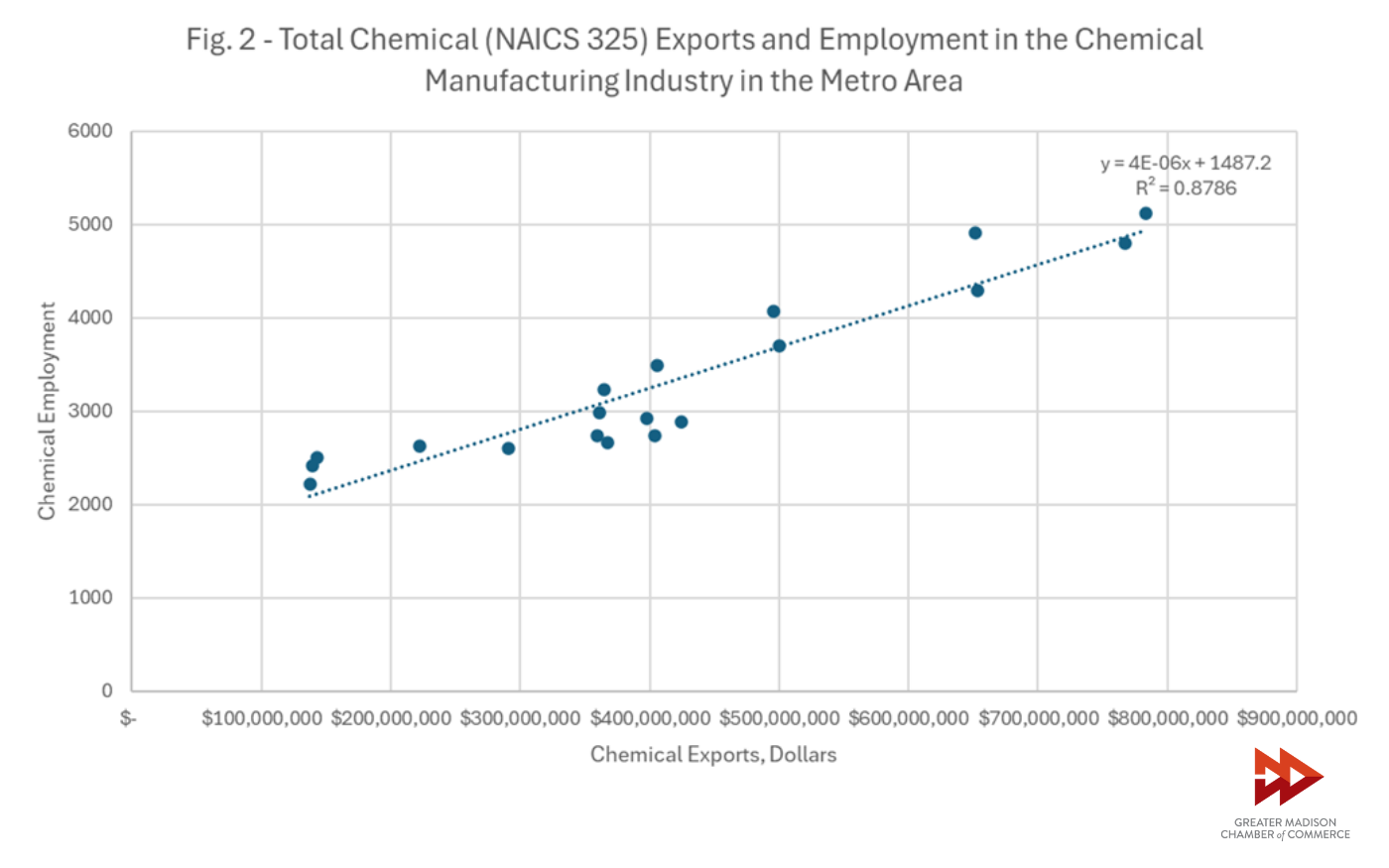
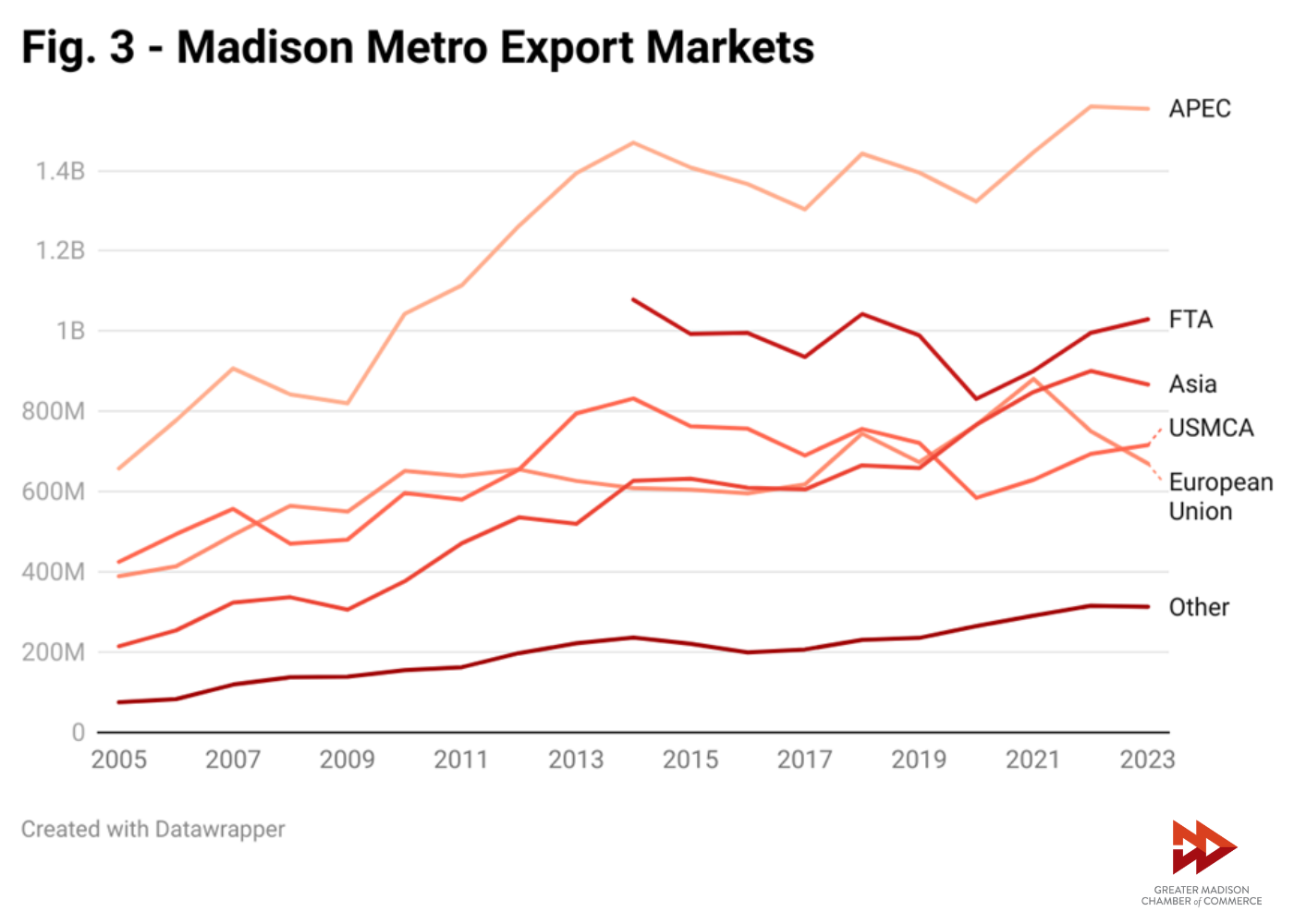
Photo by Richard Hurd
Metro Metrics September 2025

Metro Metrics is a monthly data snapshot that explores key economic indicators reflecting the health of the Madison metro economy.
Madison’s Startup Economy
As the Chamber’s 12th annual Pressure Chamber startup initiative concludes in San Francisco next month, this edition of Metro Metrics explores data on the health of the region’s entrepreneurial ecosystem.
Wisconsin Technology Council data shows that total angel and venture capital investment in Wisconsin has declined in recent years, from more than $640 million in 2022 to less than $375 million in 2024. This broadly tracks with national trends, where venture investment peaked in 2021 and 2022, followed by declines. Nationally, from 2022 to 2023, total venture capital investment declined by more than 60% according to the National Venture Capital Association’s 2024 Yearbook.
The regions of Greater Madison and Milwaukee Metro are the engines that drive Wisconsin’s entrepreneurial economy. Collectively, the two regions accounted for more than 95% of the total dollars invested in the state and more than 80% of deal flow since 2022.
Greater Madison has consistently generated a majority of the state’s investment totals. In 2024, the Wisconsin Technology Council reported the region secured $228 million from 46 deals, equaling more than 60% of the dollars raised in Wisconsin. While sizable, Greater Madison’s investment totals in 2024 declined more than 50% from two years prior.
An additional comprehensive dataset comes from the Midwest Startups Annual City Rankings, where Madison continues to be ranked among the top 10 Midwest cities for startups from 2017-2025. Some of the positive indicators include the region having both the third highest startup density (number of startups per capita) and population with at least a bachelor’s degree, as well as fifth in number of accelerators and incubators to support startup growth.
The report also highlighted some challenges compared to other peer cities in the Midwest, including startup growth since the pandemic and exit activity, an important metric that demonstrates startups can scale and yield a significant return for investors.
Similar data on new company growth was also covered in a recent Metro Metrics, showing that Greater Madison has a mid-to-low rate of establishment entries compared to peer regions such as Ann Arbor, Austin, Portland and Raleigh. An establishment entry rate of 10.33 for the high tech sector and 9.34 for non-high tech businesses means that, each year, about 10% of Greater Madison’s exiting establishments are joined by new ones. This is slightly below the national medians of 11.96 for high-tech and 10.09 for non-high tech businesses. The number of business establishments per capita in the Greater Madison region has remained roughly consistent over the past decade, with about one establishment for every 40-43 people in the metropolitan area since 2013.
